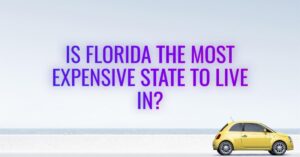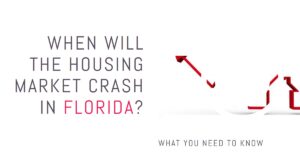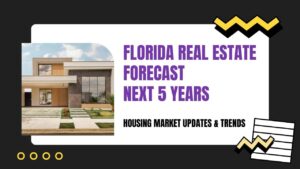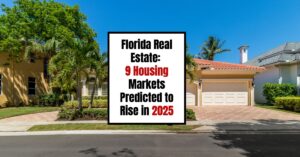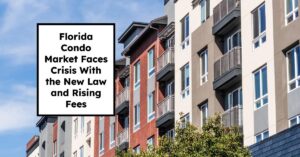Is the Sunshine State about to get a little too sunny for its own good? The Florida housing market supply has surged to a record high, leaving many wondering if this is a temporary blip or a sign of a potential housing market crash. While a crash isn't guaranteed, the increased inventory does signal a shift towards a buyer's market and increased price negotiation opportunities. Let's dig into the numbers and explore what's driving this trend, and what it means for you, whether you're a buyer, seller, or just keeping an eye on the market.
Florida Housing Market: Record Supply Expected to Favor Buyers in 2025
The Numbers Don't Lie: Inventory is Up!
According to recent data by Redfin, Florida ended January 2025 with a whopping 172,209 homes for sale. That's a 22.7% increase compared to the same time last year, and the highest inventory level since records began in 2012. To put it simply, there are more homes available on the market than we've seen in over a decade.
But it's not just the overall number that's significant. Let's break down the key findings:
- Record Highs: Overall, Florida saw housing inventory surge.
- Active Listings Surge: Active listings, which measure the total number of homes for sale during the month, rose 19.4% year-over-year to 212,437 in January. While slightly below the all-time high hit in 2019, it is still noteworthy.
- Metro-Level Spikes: A few metros saw record active listings: Cape Coral, Deltona-Daytona Beach, Homosassa Springs, Lakeland, North Port-Sarasota, Ocala, Port St. Lucie and The Villages.
Here’s a quick look at active listings in select Florida metros as of January 2025:
| U.S. Metro Area | Active Listings | Year-over-Year Change in Active Listings | At Record High? |
|---|---|---|---|
| Cape Coral, FL | 15,425 | 24.8% | Yes |
| Deltona-Daytona Beach, FL | 7,831 | 17.9% | Yes |
| Homosassa Springs, FL | 1,974 | 25.8% | Yes |
| Lakeland, FL | 7,500 | 19.7% | Yes |
| North Port-Sarasota, FL | 13,542 | 14.6% | Yes |
| Ocala, FL | 4,947 | 17.8% | Yes |
| Port St. Lucie, FL | 6,478 | 24.5% | Yes |
| The Villages, FL | 1,029 | 26.6% | Yes |
| Miami, FL | 19,942 | 23.4% | No |
| Orlando, FL | 17,770 | 24.5% | No |
| Tampa, FL | 24,259 | 17.3% | No |
Why the Sudden Surge? Peeling Back the Layers
So, what's causing this dramatic increase in Florida's housing inventory? It's not just one factor, but a combination of several key trends:
- New Construction Boom: Florida has been a hotbed for new home construction, and this influx of newly built properties is significantly contributing to the increased supply. Builders are playing catch-up to meet past demand, but the market may now be oversupplied in certain areas.
- Cooling Homebuyer Demand: Remember the frenzy of the past few years? That's definitely cooled down. Pending home sales in Florida fell 9.3% year-over-year in January, indicating that fewer people are actively buying homes.
- The Condo Conundrum: Florida's condo market is playing a significant role. Condo inventory in Florida was at an all-time high in January. New regulations aimed at ensuring condo buildings are structurally sound have caused HOA fees to soar.
- The Natural Disaster Factor: Florida is no stranger to hurricanes and other natural disasters. Rising insurance costs are pushing some homeowners, especially in coastal areas, to sell and move elsewhere. Let's be honest, the threat of losing everything to a hurricane is a serious consideration.
Key Reasons for Increased Housing Inventory:
- Increase in natural disasters
- Surging insurance costs
- HOA fee increases
- Decrease in homebuying
Coastal Concerns: Is the Tide Turning?
It's worth noting that many of the metros with record-high active listings are located along the coast. This suggests that factors like rising insurance costs and natural disaster risks are having a disproportionate impact on these areas. As mentioned above, the threat of rising costs and potential disasters could be making potential buyers hesitant.
A Buyer's Market Emerges: Time to Negotiate?
So, what does all of this mean for you? The shift in the Florida housing market is creating opportunities for buyers. With more homes available, buyers have more options and more negotiating power.
- Fewer Bidding Wars: The days of intense bidding wars may be coming to an end, at least for now.
- Negotiating Power: Buyers can potentially negotiate on price, repairs, and other concessions.
- Time to be Picky: With more choices, buyers can afford to be more selective and find a home that truly meets their needs.
As one Redfin agent in Jacksonville put it, “With this many houses for sale, a home basically needs to look like it's out of a magazine—and be priced fairly—to get multiple offers.” That means sellers need to be realistic about pricing and make sure their homes are in top condition.
Is a Housing Market Crash Imminent? My Take.
Okay, let's address the elephant in the room: Is Florida headed for a housing market crash? While I don't have a crystal ball, here's my take based on the current data and market dynamics.
- Crash vs. Correction: A crash implies a sudden and dramatic drop in prices, often triggered by a financial crisis. A correction, on the other hand, is a more moderate and gradual decline. I believe a correction is more likely than a full-blown crash.
- Inventory Still Relatively Low: While inventory is up, it's important to remember that it's still below the levels we saw before the pandemic.
- Florida's Appeal: Florida still holds strong appeal for retirees, snowbirds, and those seeking a warmer climate and lower taxes. This underlying demand should help to cushion the market.
- Interest Rates: Mortgage rates continue to play a crucial role. If rates remain elevated, it could further dampen buyer demand and put downward pressure on prices.
- Economic Factors: Overall economic health, including job growth and consumer confidence, will also influence the housing market.
Personally, I think we're going to see a more balanced market in Florida. Prices may soften in some areas, and buyers will have more negotiating power. But I don't foresee a catastrophic collapse.
The Bottom Line
- Florida's housing inventory is at a record high.
- Increased supply creates opportunities for buyers.
- Sellers need to be realistic about pricing and condition.
- A market correction is more likely than a crash.
The Florida housing market supply has indeed hit a record high, signaling a shift in market dynamics. While a housing market crash is not necessarily on the horizon, the increased inventory creates more opportunities for buyers and requires sellers to be more strategic. By understanding the underlying factors driving these trends, both buyers and sellers can make informed decisions and navigate the market successfully. It's a time for careful planning, smart negotiation, and a realistic assessment of your needs and goals.
The key is to stay informed, work with knowledgeable professionals, and be prepared to adjust your strategy as the market continues to evolve. It's an interesting time to be involved in Florida real estate, and with the right approach, you can make your goals a reality!
Work with Norada, Your Trusted Source for
Turnkey Investment Properties in Florida Markets
Discover high-quality, ready-to-rent properties designed to deliver consistent returns.
Contact us today to expand your real estate portfolio with confidence.
Contact our investment counselors (No Obligation):
(800) 611-3060
Recommended Read:
- Florida Housing Market Forecast for Next 2 Years: 2025-2026
- Florida Real Estate Market Saw a Post-Hurricane Rebound Last Month
- Florida Housing Market: Predictions for Next 5 Years (2025-2030)
- Hottest Florida Housing Markets in 2025: Miami and Orlando
- Florida Real Estate: 9 Housing Markets Predicted to Rise in 2025
- Housing Markets at Risk: California, New Jersey, Illinois, Florida
- 3 Florida Housing Markets Are Again on the Brink of a Crash
- Florida Housing Market Predictions 2025: Insights Across All Cities
- Florida Housing Market Trends: Rent Growth Falls Behind Nation
- When Will the Housing Market Crash in Florida?
- South Florida Housing Market: Will it Crash?
- South Florida Housing Market: A Crossroads for Homebuyers


